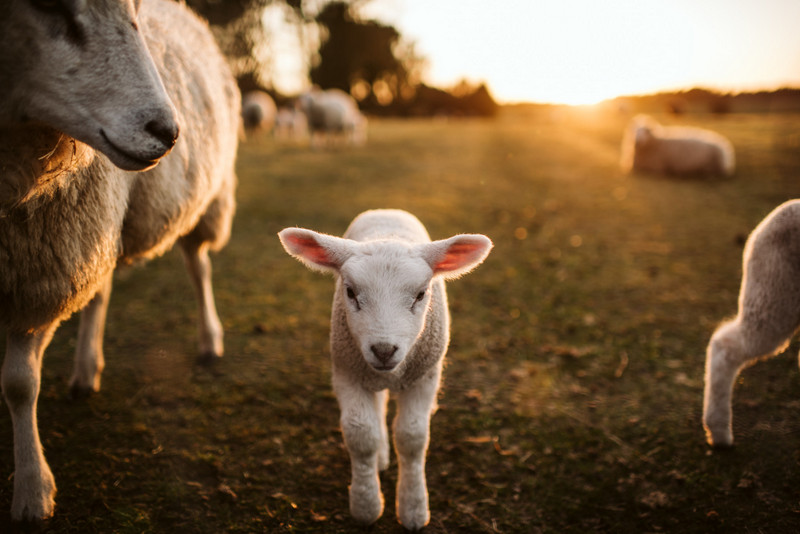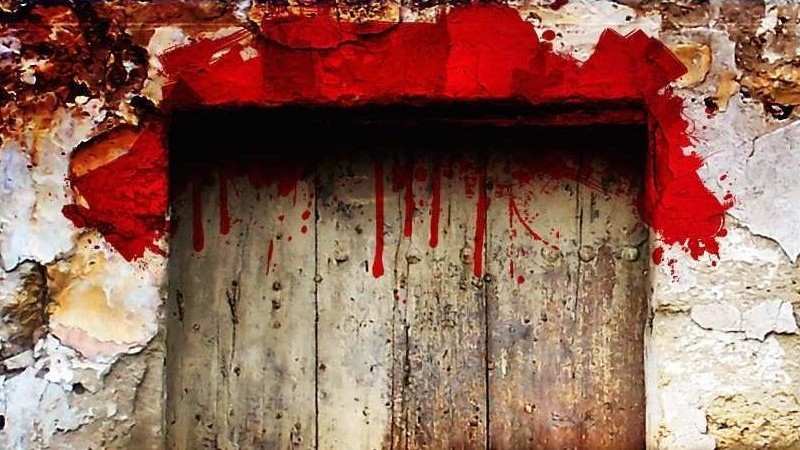
For the last 3,500 years, G-d's Chosen People have celebrated the annual remembrance of Passover and recounted how G-d redeemed the descendants of Abraham, Isaac, and Jacob from slavery in Egypt.
As a sign of His power and sovereignty, G-d inflicted ten plagues on the nation of Egypt, the last of which was the death of the firstborn of both man and beast. While they were still in Egypt, the children of Israel received the commandment to sacrifice a lamb and place its blood upon the doorposts of their homes. It was a sign of their faith that the Lord would pass over them and spare them from this final horrific plague. (Exodus 12:21-23)
Included among G-d's instructions about this first Passover was the command, "Now this day will be a memorial to you, and you shall celebrate it as a feast to the LORD; throughout your generations you are to celebrate it as a permanent ordinance." (Exodus 12:14) With few interruptions, Passover lambs were sacrificed twice each year for over 1,500 years from the time of the Exodus until the destruction of the Second Temple in 70 CE. The first Passover lamb offered each year in the first month of Nisan (Exodus 12:18) and the second Passover lamb sacrificed each year in the second month (Iyyar) as commanded in Numbers 9:9-14.

The lambs that were sacrificed during the very first Passover served the Israelites as a physical, tangible act of faith in G-d. Theirs was not some act of "blind faith"! The Egyptians and the Israelites had witnessed G-d perform a series of nine catastrophic and supernatural events. The Israelites testified to their belief in the promises of G-d by their acts of obedience.
Without a Temple or a functioning Levitical priesthood today, it is impossible for anyone to sacrifice a Passover lamb. As a result, only a shank bone stands as a reminder of the lamb in annual Passover ceremonies.
The lamb is the central element of Passover, but the second-most important component is unleavened bread and involves the removal of chametz (Hebrew: חָמֵץ [ha-mets]) and seor (Hebrew: שְׂאֹר [say-or]) from one's home or domain.
Chametz is any product containing fermented grain from the five species (wheat, oat, barley, rye, spelt).
Seor is not prevalent today, but is often translated as sourdough. Before the days of commercial, packaged yeast people would leave a quantity of dough to super-ferment and use a small piece of this dough as the starter culture for each new batch of baked goods. This barely edible medium for the yeast is called seor.
Rav Peretz Moncharsh- Chametz vs. Seor: Ask Revach
There is nothing inherently sinful about yeast but it is sometimes used in the Bible as a symbol for sin and corruption: yeast "puffs up" flour (like pride "puffs up" individuals) and, as an agent of fermentation, it causes deterioration and destruction. Yeast was not permitted in the offerings burned on the altar (e.g., Leviticus 2:11), and we are warned to avoid the "leaven of the Pharisees, which is hypocrisy." (Luke 12:1).
It was strictly forbidden for anyone to partake of the Passover lamb with leaven in their homes (see Exodus 12:8, Exodus 13:3, Exodus 23:18, Deuteronomy 16:3, etc.).
Drawing on the imagery of removing yeast from our lives as a critical activity for Passover, the Apostle Paul wrote to the believers in Corinth who were wrestling with a significant issue of sin in their congregation:
Your boasting is not good. Do you not know that a little leaven leavens the whole lump of dough? Clean out the old leaven so that you may be a new lump, just as you are in fact unleavened. For Christ our Passover also has been sacrificed. Therefore let us celebrate the feast, not with old leaven, nor with the leaven of malice and wickedness, but with the unleavened bread of sincerity and truth. (1 Corinthians 5:6-8)
Our English word "Christ" comes from the Greek word Χριστός [christos] which means "anointed one". The English word "Messiah" comes from the Hebrew word מָשִׁיחַ [mashiach] which also means "anointed one".
"Christ" and "Messiah" are synonyms.
The believers in Corinth knew the Scriptures and knew that they could not eat of the Passover lamb if they had leaven in their homes. Paul uses their knowledge and crafts a metaphor equating leaven with sin and the Passover lamb with the Messiah. If you have this (leaven/sin), then you can't participate in the other (the lamb/Messiah). Instead, Paul says, we should celebrate the feast of Passover with the unleavened bread of sincerity and truth.
There is an additional emphasis present that we should notice. Once the Passover lamb is sacrificed, participants would have only a few hours to eat it (maximum twelve hours from sunset to sunrise around the time of the spring equinox when Passover occurs). However, the events of the Passover of the Exodus demonstrate that the Israelites ate it quickly ("in haste"- Exodus 12:11). Paul notes "Christ our Passover also has been sacrificed" which would prompt the Corinthians to deal with the matter of leaven/sin quickly.
How else does the Passover lamb provide a picture of Messiah?
Lamb Selection Day
In Exodus 12:3, G-d commanded Israel to choose a lamb on the tenth day of the first month (Nisan). It was examined for five days (the 10th, 11th, 12th, 13th, and 14th) to ensure it was without blemish and suitable for its intended purpose.
Messiah entered Jerusalem on lamb selection day (John 12:1, 12-13) and was questioned for five days by the priests, scribes, Sadducees, the Pharisees, and the Romans (see Matthew 21-27). Although many attempted to trick Him or trap Him, He was without sin. Even Pilate declared three times "I find no guilt in this man." (John 18:38, John 19:4, John 19:6).
An Unblemished Male
The Passover lamb was required to be an "unblemished male" (Exodus 12:5), and the Messiah is described in the same way:
Knowing that you were not redeemed with perishable things like silver or gold from your futile way of life inherited from your forefathers, but with precious blood, as of a lamb unblemished and spotless, the blood of Christ.
(1 Peter 1:18-19 NASB)
Like the Passover lamb was physically unblemished and spotless, Messiah was spiritually unblemished and spotless.
The Times of Sacrifice
It wasn't just the Passover lamb that was offered on the day of Passover: two male lambs were also offered at their regular daily times morning and afternoon (Numbers 28:3-5).
Messiah was crucified mid-morning (Mark 15:25) and died mid-afternoon (Mark 15:34) at the times of these sacrifices.
Unbroken Bones
The Israelites were prohibited from breaking the bones of the Passover lamb (Exodus 12:46, Numbers 9:12). Although it was common for Roman soldiers to break the legs of crucified criminals to hasten their death, Messiah's bones were not broken (John 19:32-33, 36) as prophesied by King David the Psalms:
He keeps all his bones,
Not one of them is broken.
(Psalm 34:20 NASB)
The Passover Meal
The traditional Passover seder is filled with symbolism that points to the Messiah. See our haggadah for the details.
Messiah's Passover Week
The events of Messiah's last Passover week are recorded in Matthew, Mark, Luke, and John and contain the details of the days leading up to His death. We've created an interactive site called MessiahsPassoverWeek.info that connects the dots of all these events from Messiah's arrival in Bethany (John 12:1-2) all the way to the discovery of the empty tomb (Matthew 28:5-6; Mark 16:6; Luke 24:5-7; John 20:1).
GOING BEYOND THE PASSOVER
Unleavened Bread
Passover occurs on the 14th day of the first month (Nisan), the Feast of Unleavened Bread begins the following day (on the 15th) and lasts for seven days.
Unleavened bread (Hebrew: מַצָּה- matzah) is made without yeast and baked within eighteen minutes from the time the grain is exposed to moisture to ensure it does not rise from any yeast that might be present in the air.
As noted earlier, leaven sometimes symbolizes sin and Messiah was without sin. He was the "unleavened bread" (sinless man) who came down from heaven like manna:
Jesus then said to them, “Truly, truly, I say to you, it is not Moses who has given you the bread out of heaven, but it is My Father who gives you the true bread out of heaven. For the bread of God is that which comes down out of heaven, and gives life to the world.” Then they said to Him, “Lord, always give us this bread.”
Jesus said to them, “I am the bread of life; he who comes to Me will not hunger, and he who believes in Me will never thirst. (John 6:32-35 NASB)
Great care is taken to ensure matzah is made "kosher for Passover". It is prepared according to strict standards including piercing the dough to ensure no bubbles form and show even a hint of leavening. When baked, the portions heated the most turn a light- to medium-brown color in stripes on each matzah. These attributes of the matzah picture the Messiah in that "He was pierced through for our transgressions" (Isaiah 53:5 NASB) and "by His stripes we are healed." (Isaiah 53:5 NKJV)
First Fruits
The day after the first day of the Feast of Unleavened Bread is called the Beginning of the Harvest (Hebrew: רֵאשִׁ֥ית קְצִירְ- Reishit Qatzir) or sometimes called the beginning of the Feast of Firstfruits. On this day, the first ripe portion of the spring barley is harvested and dedicated to G-d as an act of faith that He will provide the remainder of the harvest.
After His death, Messiah's body was wrapped in linen and placed in a new grave (Luke 23:53). Like a seed planted in the earth that later springs up into life (John 12:23-25), His body rested in the earth but was later resurrected. Paul uses the imagery of the Feast of Firstfruits to picture the Messiah's resurrection:
But now Christ has been raised from the dead, the first fruits of those who are asleep. (1 Corinthians 15:20 NASB)
We await the full harvest of the redeemed and resurrected faithful of which Messiah represents the firstfruits!